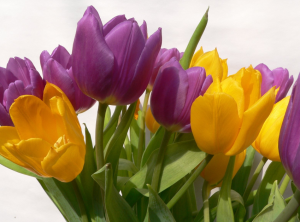Submersed Species

Fanwort
Scientific Name: Cabomba Caroliniana
Cabomba caroliniana is a submersed, rhizomatous, aquatic perennial that can have stems up to 6.5 ft. long. It has two types of leaves. The petioled, submersed leaves are opposite, and sometimes whorled, peltate in form, and are 0.75-2 in. in width. These leaves are repeatedly divided into filiform segments. The small floating leaves are few and linear-elliptic in shape, have entire margins and often have a basal notch. These leaves are 0.25-0.75 in. long. The long-peduncled (1.2-4 in.) flowers are most often white with yellow at the center, but are rarely pink or purplish. The sepals and petals are about 0.5 in. across. The petals are auriculate at the their bases, and obovate in shape. The 3 ripened carpels are flask shaped.

Rough Stonewort / Musk Grass
Scientific Name: Chara Aspera / Chara Vulgaris
Although these common lake inhabitants look similar to many underwater plants, they are actually algae. Muskgrasses are green or gray-green colored algae that grow completely submersed in shallow (4 cm) to deep (20 m) water. Individuals can vary greatly in size, ranging from 5 cm to 1 m in length. The main "stem" of muskgrasses bear whorls of branchlets, clustered at regularly spaced joints. When growing in hard water, muskgrasses sometimes become coated with lime, giving them a rough gritty feel. These algae are identifiable by their strong skunk-like or garlic odor, especially evident when crushed. Six to 16 leaf-like branchlets of equal length grow in whorls around the stem, and are never divided. These branchlets often bear tiny thorn-like projections, which give the plant a rough or prickly appearance when magnified. The round, stem-like structure varies from 5 cm to over 1 m in length. Since Algae does not produce flowers, instead microscopic one-celled sex organs called oogonia are formed. These tiny organs and patterns in the cases that surround them are used to distinguish between species. Muskgrasses may be attached to the bottom by root-like structures called holdfasts. Chara Aspera is a smaller form of Chara Vulgaris.

Waterwort
Scientific Name: Chara Aspera / Chara Vulgaris
This tiny plant is typically found growing in shallow water. Its leaves are rounded at the tip and grow up to 4 mm long.

Variable Milfoil
Scientific Name: Myriophyllum heterophyllum
Myriophyllum heterophyllum is an herbaceous aquatic plant that has stout stems up to 0.1 in. in diameter. The leaves are green and in whorls of 4-6. There are two types of leaves. The highly variable emergent leaves are bracts and can reach 4-6 in. above the water. These leaves are stiff and can be serrated to lobed along the margins, lanceolate or lance-spatulate to elliptic. These emergent leaves are 0.2-1.2 in. long and 0.06-0.2 in. wide. The submerged leaves are feather-like, pinnate, 0.8-2 in. long and 0.75-1.5 in. wide. They have 4-10 paired pinnae. Mudflat forms have 4-5 paired pinnae. The flowers are small, and the reddish, oval shaped petals are 0.0625-0.125 in. long. The fruit are subglobose in shape, have a scabrous texture and are 0.04-0.05 in. long and wide. Each of the mericarps is 2-ridged on the back but rounded on the sides, and is prominently beaked. The fruits and flowers appear from June-September.

Lowly Water-milfoil
Scientific Name: Myriophyllum humile
Compared to variable milfoil and Eurasian milfoil, lowly watermilfoil is small and low growing. This type of milfoil has vegetative elongated stems and leaves that are alternately arranged.

Eurasian Water-milfoil
Scientific Name: Myriophyllum spicatum L.
Myriophyllum spicatum is a submerged, aquatic perennial that can have green, reddish-brown or whitish pink stems 6-20 ft. long. The leaves are olive green in color, and less than 2 in. long. They are soft and feather-like in texture, and each mature submerged leaf has a central midrib with 12-20 filiform segments on each side. There are both male and female flowers on the same inflorescence. The female flowers are basal while the male flowers are located distally. The female flowers have a 4-lobed pistil and lack sepals and petals. The male flowers have 4 pink petals and 8 stamens. The globular fruit are indehiscent, 0.08-0.11 in. long and contain 4 seeds.

Bushy Pondweed
Scientific Name: Najas flexilis
Bushy Pondweed can be distinguished from other Najas species by the pointed tips of its oppositely arranged leaves.

Southern Waternymph
Scientific Name: Najas guadalupensis
This submersed annual plant has opposite leaves that are often clustered near the stem tips. The leaf base is much wider than the rest of the leaf blade. The leaves are finely toothed, 1-3 cm long and 1-2 mm wide. The entire plant is eaten by waterfowl, for which it is an important food source.

Snailseed Pondweed
Scientific Name: Potamogeton bicupulatus
This pondweed has submersed and floating leaves that are spirally arranged. The floating leaves, although not always present, have 3-7 veins.

Ribbonleaf Pondweed
Scientific Name: Potamogeton epihydrus
The floating leaves of this pondweed, when present, range from 3/4”-3 3/16” long and up to 1 3/8” wide. The submerged leaves look wilted andhave a lightly colored stripe down the center.

Thinleaf Pondweed
Scientific Name: Potamogeton pusillus
This pondweed has narrow leaves (about 2mm wide) with an inner midrib.Stipules are blunt or rounded.

Robbins’ Pondweed
Scientific Name: Potamogeton robbinsii
Also known as Fern-leaf Pondweed, this Potamogeton species has a fern-like appearance and leaves that are 3-8 mm wide.

Sago Pondweed
Scientific Name: Stuckenia pectinatus
This submersed plant has very narrow leaves (1/32”-1/16” wide, 2”-12” long) that grow in bushy clusters and emerge from a sheath towards the end of the stem.

Common Bladderwort
Scientific Name: Utricularia Vulgaris
Bladderworts are carnivorous plants which capture and digest zooplankton (microscopic animals) in clusters of “bladders” for which they are named. When in bloom, common bladderwort has small yellow flowers.

Tape Grass
Scientific Name: Vallisneria americana
Wild celery (Vallisneria americana) is a plant in the family Hydrocharitaceae (the "tape-grasses"). Contrary to the implications of its name, wild celery bears little to no resemblance to the Celery one may buy at the market. Wild celery grows under water and is consumed by various animals, including the Canvasback. The plants themselves are long, limp, flat, and have a green mid-ridge. Animals may eat the entire plant (both the leaves and the underground tubers).
Floating Leaf Species

Watershield
Scientific Name: Brasenia schreberi
Watershield is a floating-leaved plant, but the long leaf stalks reach all the way to the bottom where they attach to a long creeping root that is anchored in the mud. Watershield is occasionally found in lakes, ponds and slow streams from the northern counties of Florida, south to the central peninsula. It prefers water up to six feet deep. Watershield leaves are oval and shield-shaped. Its leaf stalks are attached at the centers of the leaf blades. Its submersed parts and undersides of leaves are covered with a viscous jelly-like substance. Its flowers are small, dull purple, and emerge from the water on a stalk.

Yellow Water Lily
Scientific Name: Nuphar sp.
Yellow water lilies have yellow flowers and large floating leaves with rounded lobes that frequently overlap.

White Water Lily
Scientific Name: Nymphaea spp.
The white water lily is a perennial plant that often form dense colonies. The leaves arise on flexible stalks from large thick rhizomes. The leaves are more round than heart-shaped, bright green, 6 to 12 inches in diameter with the slit about 1/3 the length of the leaf. Leaves usually float on the water's surface. Flowers arise on separate stalks, have brilliant white petals (25 or more per flower) with yellow centers. The flowers may float or stick above the water and each opens in the morning and closes in the afternoon. The flowers are very fragrant. White water lily can spread from seeds or the rhizomes. Submerged portions of all aquatic plants provide habitats for many micro and macro invertebrates. These invertebrates in turn are used as food by fish and other wildlife species (e.g. amphibians, reptiles, ducks, etc). After aquatic plants die, their decomposktion by bacteria and fungi provides food (called "detritus") for many aquatic invertebrates. Deer, beaver, muskrat, nutria and other rodents will consume the leaves and rhizomes of white water lily, while the seeds are eaten by ducks.

Spike Rush
Scientific Name: Eleocharis robbinsii
The soft green stems of this plant often grow clumped together with oval shaped spikelets forming at the tips.

Golden Hedge Hyssop
Scientific Name: Gratiola aurea
The oppositely arranged leaves of this plant are slightly toothed and arewidest at the base. When flowers are in bloom they are a golden yellowcolor. In Lake Singletary, the sterile, submersed form of this plant can also be found in shallow water.

Northern St. Johnswort
Scientific Name: Hypericum boreale
The stems of this submersed plant are limp. The leaves have three strongveins that come out at the base of the leaf.

Canada Rush
Scientific Name: Juncus canadensis
This rush can grow up to 3’ tall and tends to grow in small groups.

Purple Loosestrife
Scientific Name: Lythrum salicaria
Purple loosestrife is an invasive perennial wetland plant with showy purple to magenta flowers that appear from June to September. The flowers are arranged on a spike that ranges from 2 inches to 3 feet long. This plant’s leaves are typically in opposite pairs that alternate down the stem at 90 degree angles, but sometimes occur in whorls of three or four.

Arrow Arum
Scientific Name: Peltandra virginica
This emergent wetland plant has bright green arrow- to heart-shaped leaves with rounded triangular lobes and veins that radiate from a central vein. This plant is often confused with arrowhead (Sagittaria sp.), which is distinguished by its pointed lobes and veins that radiate from one point.

Soft-Stemmed Bulrush
Scientific Name: Scirpus validus
Soft-stemmed bulrush is an emergent wetland plant with soft stems that grows up to eight feet tall and 3/4” thick. Drooping oval spikelets covered in reddish-brown scales emerge in clusters just below the top of the stem.

Bur-reed
Scientific Name: Sparganium sp.
Bur-reed is an emergent wetland plant that typically grows up to two feet tall. Its bright green, strap-like leaf blades grow up to 1 inch wide. Its spherical flower heads are green in early season, becoming brown and bur-like later.

Broadleaf Cattail
Scientific Name: Typha latifolia
And last, but not least, the Typha latifolia (Bulrush, Common Bulrush, Broadleaf Cattail, Common Cattail, or Cat-o'-nine-tails) is a perennial herbaceous plant in the genus Typha, which grows in temperate, subtropical and tropical areas throughout the Northern Hemisphere. It grows in marshy areas and flowers in mid to late summer. The common cattail shares its range with other related species, and hybridizes with Typha angustifolia, narrow leaf cattail, to form Typha x glauca (Typha angustifolia x T. latifolia), white cattail. Common cattail is usually found in shallower water than narrow leaf cattail. The plant is 1.5 to 3 meters high and it has two to four centimeters broad leaves. The rhizomes of Typha latifolia were eaten by many first peoples of North America, as well as the leaf bases and young flower spikes. The rhizomes can be consumed after cooking and removing the skin, while the peeled stems and leaf bases can be eaten raw or cooked. While Typha latifolia grows all over, including in rural areas, it is not advisable to eat specimens deriving from polluted water as it is used as a bioremediator, it absorbs pollutants. Do not eat them if they taste very bitter or spicy.









